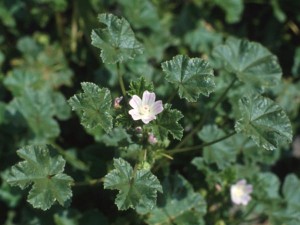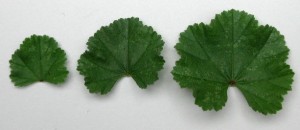This little weed grows everywhere, and in the US is commonly known as buttonweed, cheeseplant, cheeseweed, dwarf mallow and roundleaf mallow. The plant is an invasive in the United States. The common mallow is part of the family Malvaceae whose plants include cotton, okra and hibiscus. It is an edible plant that has been used for medicinal care as well as food. The fruits are round and have cheese-like wedges which give the common mallow its nickname, cheese plant. Mallow stems are flexible and come from a central point, often lounging on the ground.
Common mallow is a winter or summer annual or biennial, branching from the base, with a prostate growth habit. This low growing weed has a deep fleshy tap rood. The seeds germinate though the summer and the broken stems can take root; one of the reasons it can be so difficult to get out of your garden or lawn. Depending on region and plant type, the leaves can range from a few centimeters to almost 6 centimeters wide. Common mallow leaves are alternate, on long petioles, circular to kidney-shaped, toothed and shallowly 5-9 lobed, 2-6 cm wide. Short hairs present on upper and lower leaf surfaces, margins and petioles. The flowers vary; having 5 petals they can be white, pinkish, or lilac flowers that measure on average 1 to 1.5 centimeters across.
This plant is not native to America and originated in Europe, Asia, and Northern Africa and is also in the Americas and Australia. You can find the common mallow growing in lawns, gardens, roadsides, cropland, and waste areas.
Although often considered a weed, this plant is often consumed as a food.This wild edible is used as herbal medicine in a variety of ways; it is an anti-inflammatory, diuretic, demulcent, emollient, laxative and an expectorant.
All parts of this plant are edible. The leaves can be added to a salad, the fruit can be a substitute for capers and the flowers can be tossed into a salad. When cooked, the leaves create a mucus very similar to okra and can be used as a thickener to soups and stews. The flavor of the leaves is mild. Dried leaves can be used for tea. Mallow roots release a thick mucus when boiled in water. Common mallow leaves are rich in vitamins A and C as well as calcium, magnesium, potassium, iron and selenium; this is especially true of the seeds, which contain 21% protein and 15.2% fat.
Jon




While researching this little weed (malva neglecta), I ran across your site. Very nice.
Just wanted to tell you that my husband’s grandmother called this plant “Cow Shit Weed”–because it always grew in her pasture. She dried the plant and always had some on hand. She not only drank tea made from the dried leaves, but she also used the tea as an eye-wash. Mary
Thank you for that information. I’m glad you enjoyed the article. It’s a fun hobby learning what is edible, and it has always surprised me what we can find in our yards and gardens.